The story, as related by Sir Thomas More and then William Shakespeare, involved two attempts to kill Edward and Richard, with the second being successful.
On July 17th 1483, Richard appointed a long-time ally and supporter named Robert Brackenbury to the position of Constable of the Tower. This was now the man charged with the day to day care of the two royal boys.
Three days later, Richard III left Windsor to begin the tour of his realm. On July 29th, the king reached Gloucester. Now safely distanced, he dispatched a rider named John Green with a verbal message for Brackenbury back at the Tower of London.
The message asked the Constable to murder the children. But Brackenbury knelt before 'Our Lady of the Tower' (the Virgin Mary in the chapel) and swore that he would not do it, even if it meant his own death for refusing.
John Green rode away with this message. He caught up with his king at Coventry, on August 15th, and told him about Brackenbury's refusal. Richard apparently then went to the toilet. He sat there, muttering to himself, while he engaged in a long number two. His monologue was along the lines of 'who will rid me of these turbulent princes?'
A young boy - a page of the Chamber - overheard him and suggested that James Tyrrell would do the job. Tyrrell was the man who slept each night across the threshold to Richard's bedroom door. He wasn't actually there as a draught excluder. He was to ensure that no-one interrupted the king's sleep. Tyrrell was naturally looking for promotion.
Bowels cleared, Richard thanked the page for his recommendation of a murderer and promptly sent for James Tyrrell. This was a man with a criminal record, who jumped at the chance to do this thing. He was sent to London, ostensibly to collect some robes, so that Richard's son could be proclaimed Prince of Wales (in Yorkshire) in style.
(Slight verifiable discrepancy here. Tyrrell did indeed go to London for the robes, but not on August 15th from Coventry. The King's Wardrobe Accounts state that he left on August 30th from York.)
Sometime in early September (one historian, Alison Weir, worked out that it was September 3rd 1483), Tyrrell - with his accomplices John Deighton and Miles Forrest - arrived at the Tower of London. Brackenbury, after swearing that he'd rather die than see harm come to those children, and after undertaking a job which restricted all access to the boys, apparently just opened the door for the asking of three assassins.
Tyrrell and Deighton promptly smothered Edward V and Richard of Shrewsbury with pillows as they slept.
The bodies were then carried down the spiral steps of the north-eastern tower of the White Tower, across the open courtyard, down the slope and into the gateway of the Bloody Tower. There an open grave had been prepared at the foot of the main staircase. The boys were buried with their golden robes (which must also have been conveyed to the spot), only to be uncovered in 1674, when restoration work was being undertaken in that area.
All this without the three hundred denizens of the Tower of London seeing them or suspecting a thing.


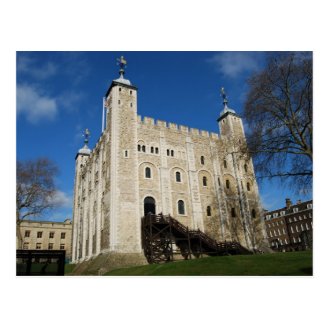


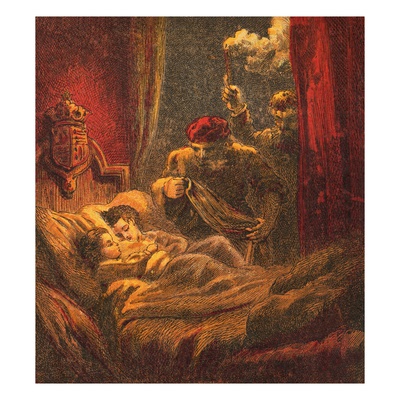
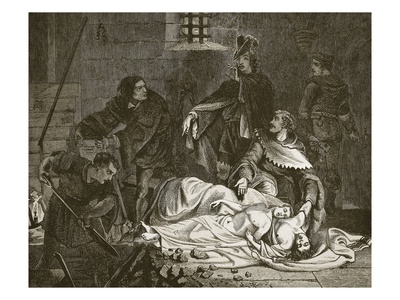
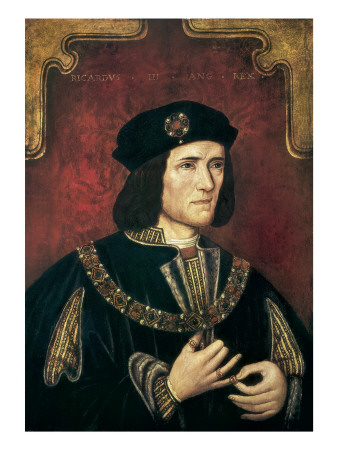
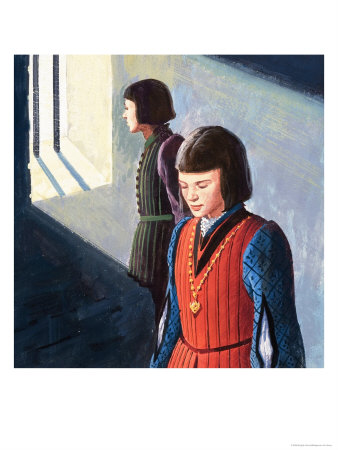
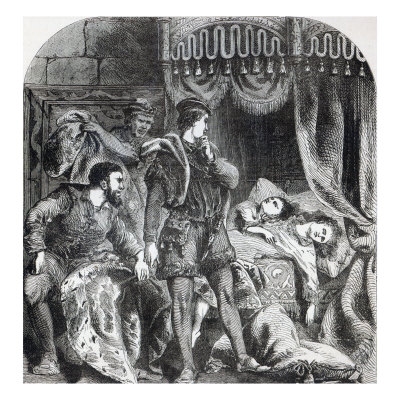






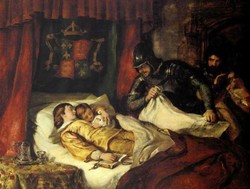

 St Tydecho's Churches in West Waleson 09/03/2014
St Tydecho's Churches in West Waleson 09/03/2014
 Goodies for an Outlander Premiere Partyon 03/06/2015
Goodies for an Outlander Premiere Partyon 03/06/2015
 Holocaust Memorial Day Interview with Rainer Höss, Grandson of Rudolf Architect of Auschwitzon 01/24/2015
Holocaust Memorial Day Interview with Rainer Höss, Grandson of Rudolf Architect of Auschwitzon 01/24/2015
 Romantic Valentine Gifts for an Outlander Fanon 01/16/2015
Romantic Valentine Gifts for an Outlander Fanon 01/16/2015

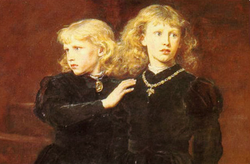
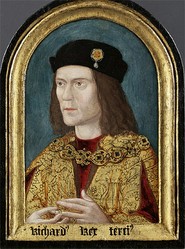
Was Richard III guilty or innocent of this murder?
SAINT Thomas More related the confession of the Princes' killer... Shakespeare's use of that is fiction...historical fiction... NOT an historical account... Richard III was supposed to PROTECT his nephews. And, I've never seen any accounts of any search being made for the two boys or their abductor or murderer. Your two nephews disappear and you aren't even mildly curious as to what happened to them? Shakespeare wrote his play during Elizabeth I reign... Way too late for it to be propaganda. Saint Thomas More is known for his integrity and the strict religious code he lived by... he was beheaded by Henry VIII because he refused to tell a lie that would have saved his life...
Innocent. I have always found the tale of Brackenbury's refusal hard to fathom. For one thing, based on the vile reputation Richard supposedly had at this time after Hasting's execution, how long would Brackenbury have lived had he really refused an order from so evil a king? Brackenbury would have been a loose end, knowing what he knew, and had Richard wanted the boys dead in secret, how could he trust Brackenbury not to tell? Second, Brackenbury remained loyal to Richard, dying with him at Bosworth. Would he have done that for a man who asked him to murder his own nephews? I think not. But, there is one last point I'd like to share. One argument during the Trial of RIII referenced in another post, was that Buckingham would not have acted without Richard's knowledge had he ordered the deaths of the two boys. I say if Buckingham wanted the throne for himself, he most definitely would have moved against Richard while the newly-crowned king was out of London. Buckingham was not a Yorkist. He was forced to marry one of the queen's sister's during Edward IV's reign, had no position of power until he joined Richard at Stony Stratford, and he considered the boys Woodvilles, whom he detested. It is entirely possible that such a man would not let 2 little illegitimate Woodville boys stand in his way when he hated their family.
HE was innocent in my opinion. I never felt that he had those boys murdered. He had no need to. In my mind, it would have been Duke of Buckingham. I doubt it was Henry Tudor He was married to these boys' sister and he loved her. I don't think he'd have had her brothers killed.
Henry Tudor, or his mother Margaret, make the most sense to me. Two princes disappear, with rumors of their ill-being circulated to prime the country for a rebellion against the sitting king (Richard III), and then with Tricky Dick out of the way, Henry Tudor marries their sister, Elizabeth of York. Perhaps she wouldn't have been readily accepted as queen in her own right, but her claim would have been far stronger than just Henry on his own.
Richard reigned for only two years. Supposing he was victorious at Bosworth and ruled for many more years, he would have to make some comment about the fate of the princes. Perhaps he would bring them out of hiding ... In Middleham, or Burgundy?
Frank - I've seen a similar theory dramatized. It makes the most sense of all.
Kathy - You'll find no argument from me there. Henry Tudor had the biggest reason of all. If only he'd had the access, then he'd be suspect number one. Though I do look on in grave suspicion the fact that his mother DID have access.
Poison is easy to administer. Anyone can do it. Digitalis, foxglove poison, was well known long before the princes in the tower case, and it leaves no outward signs. Furthermore, it could be smuggled into a place as an innocuous drink. Mixed with wine it cannot be tasted. The most effective murder technique!
Definitely innocent! I don't believe he had a reason to have them killed; however, Henry Tudor, Lord Stanley & Duke of Buckingham all had reasons to have them killed.
Parliamentary decisions can be reversed. Here's a scenario: 'Witness' steps forward and says that Lady Eleanor died before Edward married Elizabeth. Now he's free to marry. Now the kids are legitimate. Now Edward V is king again. It's no less dodgy than the Bishop of Bath and Wells suddenly having officiated at a secret ceremony, of which there is no legal record.
But for such things to play out, Edward V needs to be free and/or his supporters need to have him to crown. As long as he's safe and sound in the Tower, no-one is stepping forward to 'witness' anything.